

Touring the Once-Abandoned Carrie Furnace in Pittsburgh
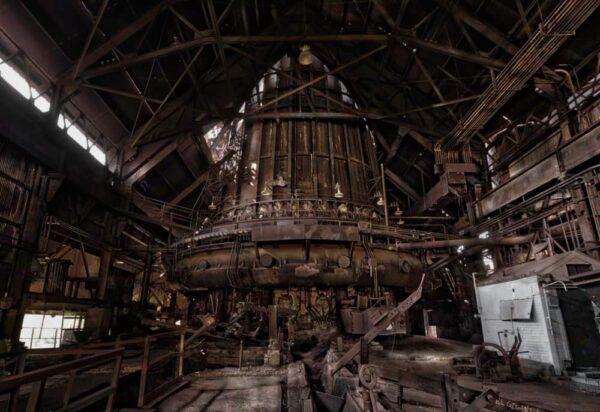
As I walked away from Carrie Furnace, having spent the previous two hours touring this relic of Pittsburgh’s steel industry, I knew I had just been somewhere special.
Without a doubt, Carrie Furnace is a microcosm of the changes that have occurred in Pittsburgh over the last few decades. What’s old is becoming new again. What was once polluted is becoming green. And what was industrial is becoming artistic. If you want to understand where Pittsburgh has been and where it is going, there is no better place to visit than Carrie Furnace.
Located just outside the Pittsburgh city limits, Carrie Blast Furnace was once part of the Homestead Steel Works. The two furnaces that make up the site were built in 1907 by Carnegie Steel and ran almost continuously until 1978.
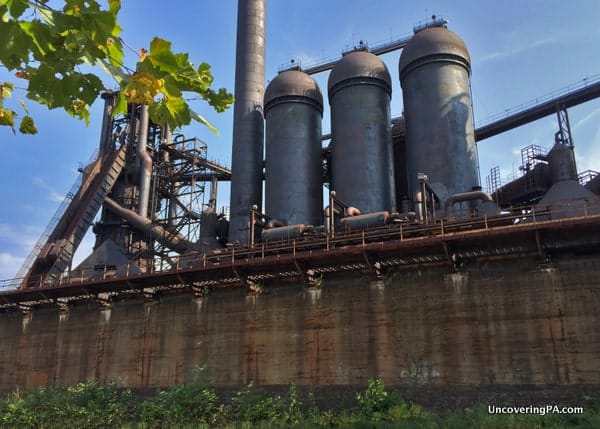
Pittsburgh is known as “The Steel City,” and for good reason. At its peak in 1910, the steel industry in Pittsburgh produced more than 60% of the total production in the US. The peak period of production at Carrie Blast Furnace was in the 1950s and 1960s, when the seven blast furnaces here were each producing 1,250 tons of iron ore every day.
During the 71 years of operation, changes were made to the blast furnaces, but they remained virtually unchanged after 1936. This outdated technology was one of the chief reasons that furnaces 6 and 7 were the first ones shut down when the complex began to shut down. It was also the reason that these were the furnaces chosen for preservation by Rivers of Steel National Heritage Area.
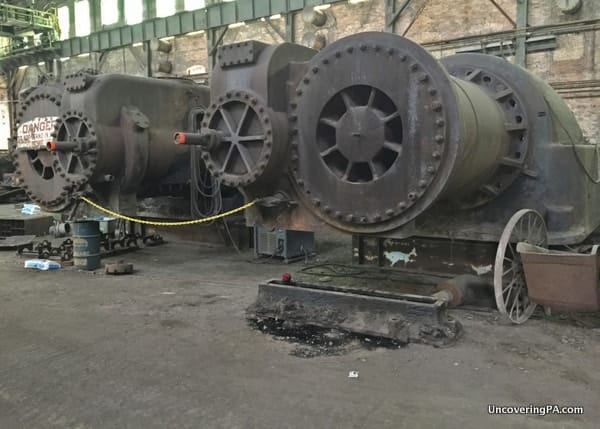
After years of work to preserve the site, tours of Carrie Furnace started running in 2010. Having seen photos of the site when planning my trip to Pittsburgh , I knew that this was somewhere that I had to visit.
My visit started in the site’s visitor center. Currently, the visitor center consists of little more than a sign-in table and a small waiting area. The vast majority of this very large building, which used to provide a massive amount of air to the furnaces, is used for storage for a variety of pieces of machinery and equipment that the site hopes to restore. If you look across the building, you’ll notice a large US Steel safety sign emblazoned with the three hypocycloids that have been made famous by the Pittsburgh Steelers.
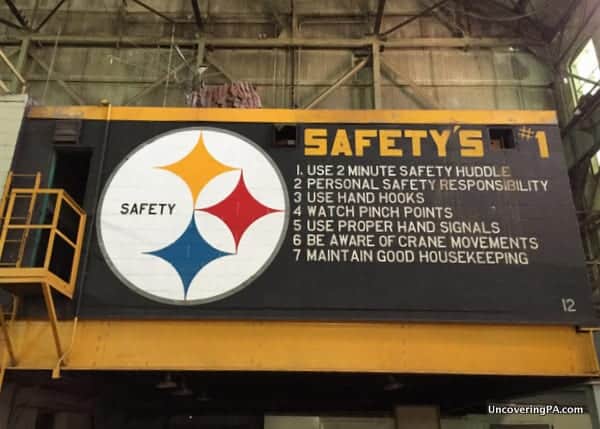
Tours of Carrie Furnace take 1.5-2 hours and are often led by former steel workers. The tour takes visitors throughout much of the site, explaining the Carrie Furnace history, how iron was made here, and how that was turned into steel across the Monongahela River in Homestead.
The highlight of any visit to Carrie Furnace is walking around the furnace itself and learning how iron was made. While certainly on a larger scale, the process of making iron had changed little since the 18th century iron furnaces I’ve visited in eastern Pennsylvania.
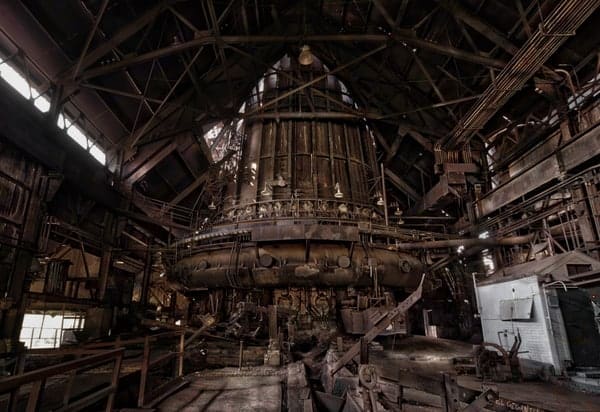
While the area has been cleaned up a bit, it is still quite rough around the edges, and really has the feel of exploring an abandoned site. Work continues on the site to improve access and make it safer for visitors. And while this is needed in places, I hope that it doesn’t take away from the very cool urbex feel of the site.
Back outside the furnace, take note of some of the graffiti that is present at the site. It’s not surprising that a place like Carrie Furnace would have issues with graffiti, especially since it was sitting abandoned for many years. To combat this, Carrie Furnace works with the art community and allows sections of the facility to be used by graffiti artists. This cooperation has greatly reduced the amount of unwanted graffiti that occurs on the site and provides a wonderful artistic touch to the harsh metal of the furnace.
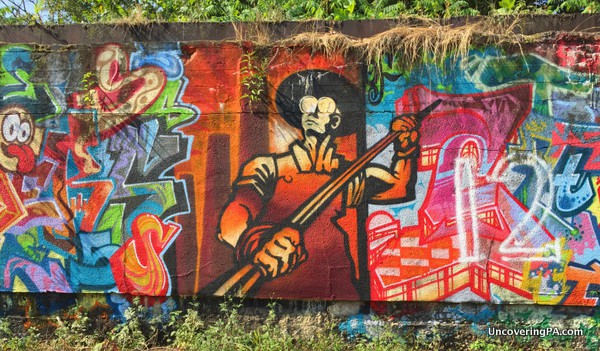
Another piece of art on the site is the “Carrie Deer.” Standing 45-feet tall and hidden amongst the structures of the furnace, this deer head is made entirely of pipes and other materials found on site. Constructed by renegade artists between 1997-1998, this piece of art has now been preserved and even has its own documentary.
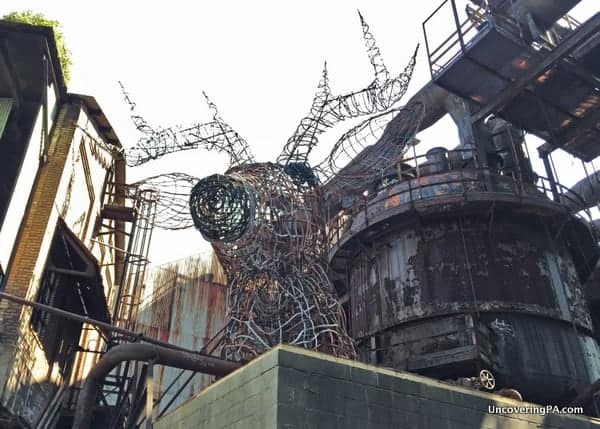
Those interested in the art and graffiti history of the site can take the Carrie Furnace Urban Art Tour, which covers more than 30 years of art. Carrie Furnace also hosts period art exhibits that are popular with visitors.
Another interesting area is known as the Iron Garden. This area is located where furnaces 1 and 2 once stood. Since the land was used for heavy industry for nearly 100 years, the soil was deeply affected and heavily acidic. Minus some basic maintenance to maintain walking paths, this area has been left to grow back completely naturally.
Ten different signs lead visitors through the Iron Garden and explain how nature is reclaiming the land. I found it very fascinating to see how plants are growing in this area despite the poor soil and large pieces of metal scattered throughout the land. I’ll be very interested to come back in a few years and see how this area has changed.
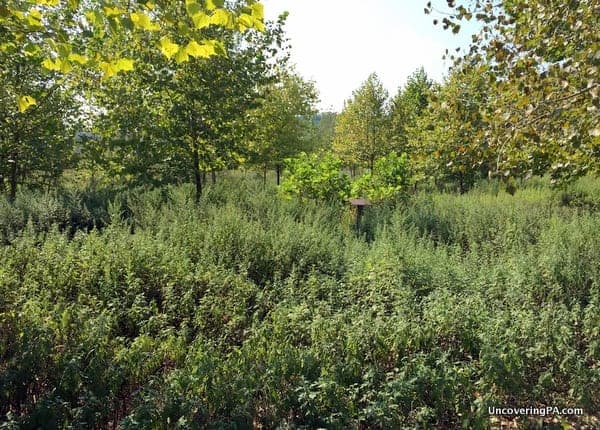
The Iron Garden is just one example of the environmentally-friendly practices that have been worked into Carrie Furnace. The site also uses solar panels for electricity, goats maintain portions of the land, and waste is composted. While the steel industry was blamed for so much of Pittsburgh’s pollution problems in the mid-20th century, it’s amazing to see the furnace leading the way in Pittsburgh’s green movement today.
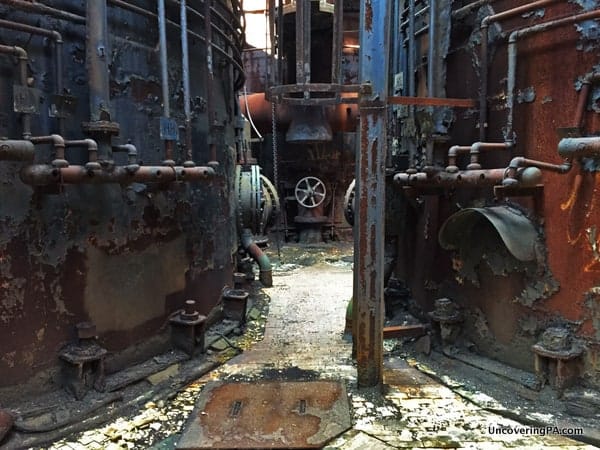
I really can’t express how awesome my visit to Carrie Furnace was. Whether you are interested in Pittsburgh’s industrial history , love exploring abandoned places , consider yourself an art aficionado, or just like taking awesome photos, put a tour of Carrie Furnace at the top of your must-do list.
Things Worth Noting Before Touring Carrie Furnace
Carrie Furnace is an industrial site and is still far from pristine. My trip took me up shaking stairs, past rusting metal, and over equipment that hadn’t been moved in decades. All visitors are required to sign a waiver before touring the site. It’s also worth noting that Carrie Furnace is not handicap accessible and only closed-toed shoes are allowed on the tour. Given the nature of the tour, it is not recommended for children under eight.
If you want to learn more about the area’s history, Carrie Blast Furnace is just across the river from the site of the Homestead Strike of 1892. Tucked between the river and a large shopping center, the site features the old Pump House, a large water tower, and several pieces of equipment scattered on the ground.
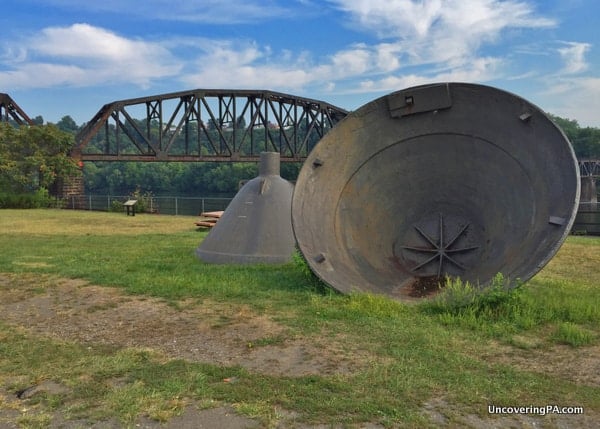
It was on this site in July 1892 that a battle ensued between striking workers and forces brought in by Carnegie Steel. Several signs on the site tell the story of what happened here.
Also nearby is the Bost Building, which serves as the Rivers of Steel Museum. Further afield is the W.A. Young and Sons Machine Shop and Foundry in Rices Lading.
Note: My tour of Carrie Furnace was hosted by Rivers of Steel National Heritage Area. However, the opinions expressed are my own.
Spending more time in Pittsburgh? Check out the Tour-Ed Mine , the Heinz History Center , the Westinghouse Atom Smasher , and the Nine Run Falls Trail .
You can also check out a few of my favorite seasonal museums in PA .
Carrie Furnace
See map below for other area attractions.
Great places to stay in Pittsburgh
- Renaissance Hotel - One of the city's highest-rated hotels on Trip Advisor.
- Residence Inn North Shore - The perfect hotel for sports fans
- Hampton Inn and Suites - The only downtown hotel with free parking
- Hyatt Place - Great value near great attractions
- Find more great places to stay on Vrbo!
Click the map to see more nearby things to do
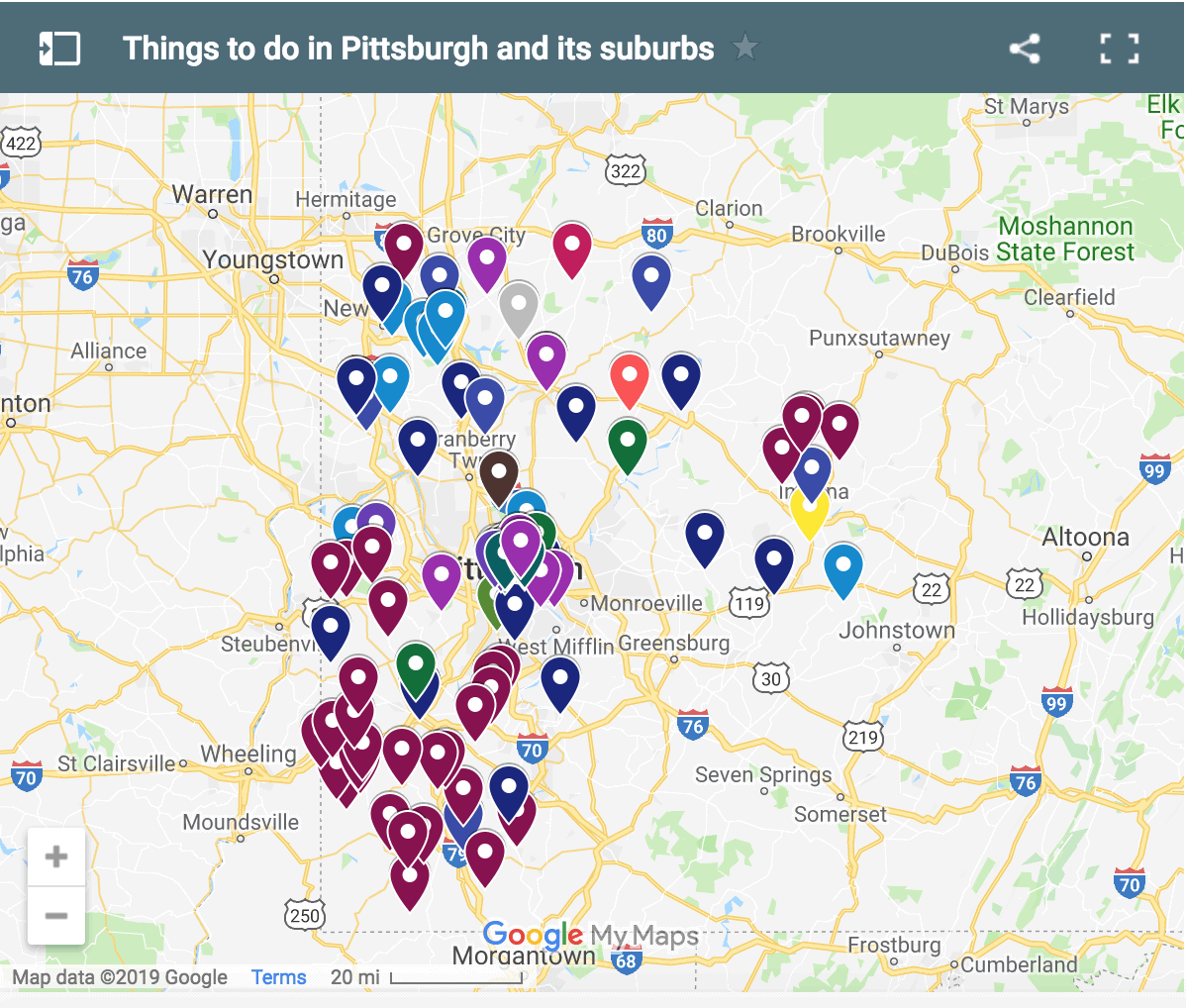
More nearby places worth exploring
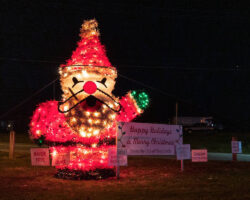
What It’s Like to Drive Through the Cascade of Lights in New Castle, PA

Exploring the Pittsburgh Zoo and Aquarium in Highland Park
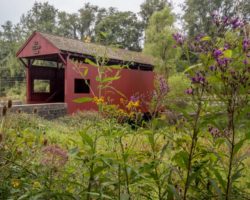
Visiting the Covered Bridges of Washington County, PA
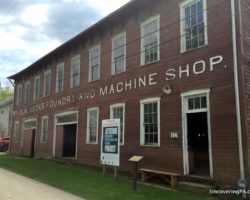
Exploring the W.A. Young and Sons Machine Shop and Foundry in Rices Landing, Pennsylvania
Find more things to do in the pittsburgh region.

Jim Cheney is the creator of UncoveringPA.com. Based in Carlisle near Harrisburg, Jim frequently travels around Pennsylvania and has visited, written about, and photographed all 67 counties in the state. He has also traveled to more than 30 different countries around the world.
7 thoughts on “Touring the Once-Abandoned Carrie Furnace in Pittsburgh”
Thanks for sharing – I’ll have to check this place out. In addition to the deer, there also was an enormous owl that was created inside one of the buildings… Unfortunately, it had to be dismantled by one of the crews that was brought in to work on the place. Both were the partial works of Tim Kaulen, Pittsburgh sculptor.
Interesting. I hadn’t heard that, but I know that they had to remove some of the art in order to preserve the site itself.
Jim, that looks like a place I could spend days! I’ll certainly plan a visit next time I’m out that way. One quick technical note, from paragraph four: this mill would have consumed 1250 tons of ore, or produced 1250 tons of iron, but it wouldn’t have produced iron ore, that comes from the ground! Thanks again for some great reading.
I was going to point out that the seven blast furnaces “processed” 1250 tons of iron ore per day, not produced…but I see that Jeff beat me to it.
Chris you were right in saying produced 1250 Tons/day. Iron making though is a process that results in the production of 1250 tons of molten iron which is then processed into steel. You may ask “How would this guy know?” Well this guy directed iron making operations for almost 38 years starting with Republic Steel in Youngstown Ohio. Republic Steel recruited me while I was working steady midnights at US Steel in McDonald so I could attend YSU in the evenings. This was around 1970. By the way in Youngstown Ohio within its’ city limits 17 Blast Furnaces operated. Many others operated within 15 miles of Youngstown also. The tragedy is that not one of them is standing. Pity
I’m going to have to take a trip and see these furnaces. Once a Blast Furnace Man always a Blast Furnace Man.
Hard to explain…….probably the only others that would understand were those who worked on Furnaces.
About 38 years ago, I worked for Duqesne Light as a meter reader. Across the Mon from the Clairton Mill Works were semi-abandoned homes right along the river. It was really creepy back then. I can’t imagine that anyone lives there any more. I wish I could give you better directions but I haven’t lived in Pittsburgh since 2001.
You might want to take a drive out and see what’s left.
Right up the street is US Steels Edgar Thomason’s plant that has the last two blast furnaces in PA. They produce over 8000 tons of iron a day.
Leave a Comment Cancel reply
Sharing is caring.
Help spread the word. You're awesome for doing it!
- Mission and History
- Board of Directors
- Awards and Honors
- Join or renew
- Donate to PGS
- Code of Conduct
- Job postings
- Summer 2024 field trip photos
- Student Night
- 2024 Field Workshop
- PGS Scholarship
- Corporate Sponsors
- Geologic Consultants
- Maps and Diagrams
- PGS Newsletters
- PGS Field Guides
- PALS Brochures
- Geologic Web Links
- Local Geo-Hazards
Carrie Furnace Field Trip Announcement – Saturday, June 24, 2023
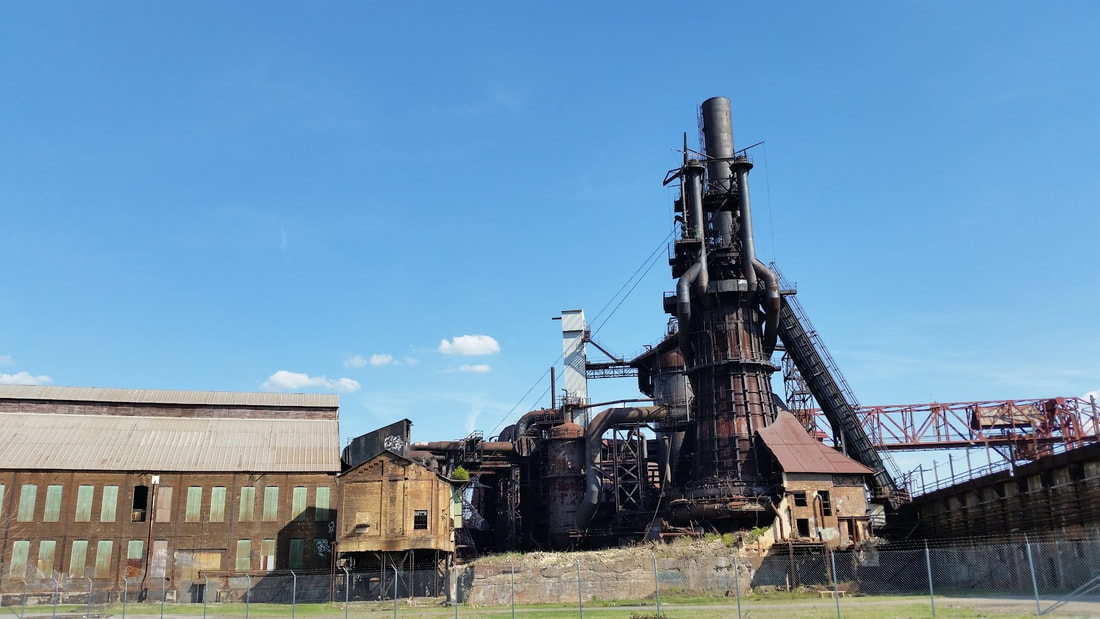
Registration form for carrie furnace tour
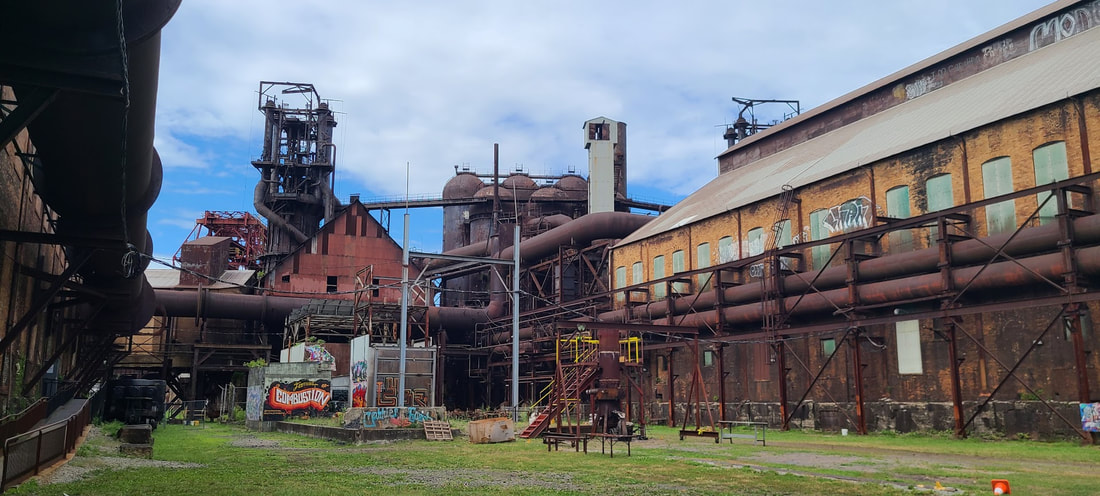
- Social distancing: Social distancing is no longer mandatory, but we do ask that you be mindful of the people around you, allowing for a comfortable amount of space when possible.
- What to wear: The majority of each tour is outside; please dress for the weather. Additionally, the ground is uneven—sensible shoes are a must. Sneakers or boots are recommended. Open-toed shoes and high heels are prohibited .
- Hard hats are required to be worn for the duration of your tour. If you have a hard hat, please feel free to bring it. For those who need one, a hard hat will be provided and collected after the tour. Hats are disinfected between uses.
- Restrooms & concessions: The rawness of the site is certainly part of its charm. However, that rawness also limits the creature comforts many of us are accustomed to, like running water. Portable bathrooms and wash stations are available. Food amenities are generally not available (with some exceptions, such as food trucks at festivals).
- Photography: Photography is permitted. For safety reasons, videography and drones are prohibited.
- Accessibility: Handicapped parking is available, but the grounds covered during tours are not wheelchair accessible. There is one spot where the steps are steep, but a handrail is present.
- Liability: By purchasing admission tickets, all visitors are required to sign a liability waiver to tour the Carrie Furnace and consent to be photographed . The PGS also will have a liability waiver to sign.
- Bug Spray: We will be outside, so bug spray with tick repellant might be useful.
- Restaurants: A list of nearby restaurants will be made available, if participants would like to eat together after the tour.

Rivers of Steel Heritage Tours

Explore Pittsburgh's industrial roots at Carrie Blast Furnaces.

The Industrial Tour at the Carrie Blast Furnaces
Rivers of Steel’s attractions showcase the artistry and innovation of the Pittsburgh region’s industrial and cultural heritage.
The Industrial Tour at the Carrie Blast Furnaces takes place on the grounds of a vestige of Pittsburgh’s 20th-century domination of the steel industry. Towering 92 feet over the Monongahela River, the Carrie Blast Furnaces are rare examples of pre-WWII iron-making technology. Since the collapse of the region’s steel industry in the 1970s and ’80s, these are the only non-operative blast furnaces remaining in the region. On an Industrial Tour of Carrie, visitors learn about the site’s iron-making technology, its workers, and their culture.
Join Rivers of Steel on board the Explorer riverboat for the Uniquely Pittsburgh Sightseeing Tour. This 90-minute excursion seeks to answer the question “What makes Pittsburgh, Pittsburgh?” Traveling on the Ohio, Monongahela, and Allegheny Rivers, this tour shares the big stories of our region’s past—along with many lesser-known tales—as it explores a sense of place. Sit back, enjoy the skyline, and see the sights as you discover how Pittsburgh’s unique history shaped the city we have today!
Rivers of Steel Heritage Tours
Rivers of Steel is your resource for one-stop receptive tour services in the Pittsburgh region, in addition to premiere cultural heritage attractions.
As a receptive travel partner, Rivers of Steel works with you to design a customized group tour itinerary that showcases the best of the region. You’ll deal with one person for all billing and logistical details of your tour, and you’ll have the confidence that comes with working with a dedicated nonprofit organization. Each tour package includes a knowledgeable local step-on guide, whether you’re planning a “Pitt Stop” en route to another destination or are spending multiple days in the region.
Some of our most popular tour packages:
Narrated driving tours of Pittsburgh
Babushkas and Hard Hats: The Steel Heritage Tour
Pittsburgh Places of Worship
Pretty as a Picture: An Artistic Exploration of Warhol’s Hometown
Gardens and Glass
A Beautiful Day in the Neighborhood: The Fred Rogers Tour
Student STEAM and Performance tours
Wright This Way to the Laurel Highlands
The Revolutionary Spirit (French & Indian War and Whiskey Rebellion)
Celebrate the Season
Barn Stars & Covered Bridges: Country Living in Western PA
Jimmy Stewart: A Star is Born
City of Champions (Sports Galore)
We plan for all ages and interests, and look forward to designing a tour for your travelers! When we create an itinerary for your travelers, we do more than plot a route – we tell a story!
Jaimie Hanson 623 East 8th Avenue, Homestead, PA 15120
412-464 -4020 Ext. 246
www.riversofsteel.com

Discover the Burgh
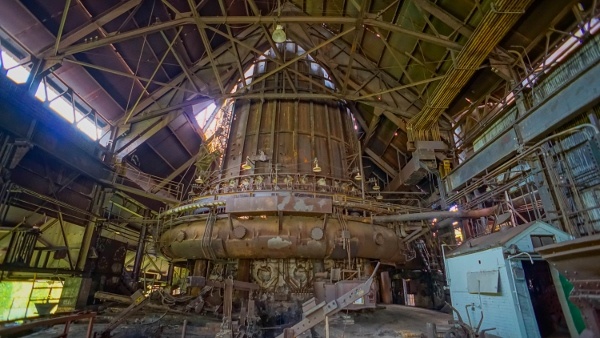
Carrie Furnace Tour – Finding the Steel City’s Roots
Would you like to save this article.
We'll email this article to you so you can read it again later!
I agree to receive periodic emails from Discover the Burgh
Published by Jeremy . Last Updated on August 24, 2024.
Disclaimer : Our site uses demographic data, email opt-ins, display advertising, and affiliate links. Please check out our Terms and Conditions . Pricing, operating hours, or menus may have changed since our initial visit and may not be reflected in subsequent updates. Please confirm these directly with any business or attraction prior to visiting.
Throughout its history, Pittsburgh has been known for a lot of things. The city was host to George Washington on multiple occasions, the departure point of Lewis and Clark on their famous expedition, home to America's early glass industry, and the world's leading supplier of iron and steel- and that is before even getting to the 20th century.
Although these are all incredible in their own right, it is the steel industry in Pittsburgh that made the city famous the world over.
In its prime, Pittsburgh was producing thousands of tons of steel per day- more than half of the entire output of all factories in the United States combined- and boasted a staggering number of mills located along the city's rivers. But by the 1980s this all changed- the steel industry went bust, nearly all of the factories were shut down, and Pittsburgh went through one of the largest depressions from which it only recently emerged.
Since then, most of the factories have been demolished and replaced with new industries. But a small portion of one massive factory, the iron-producing Carrie Furnaces, was rescued by the Rivers of Steel Heritage Foundation and turned into a historical site for future generations to come and learn about how the Steel City got its name.
The Roots of the Steel City at Carrie Furnace
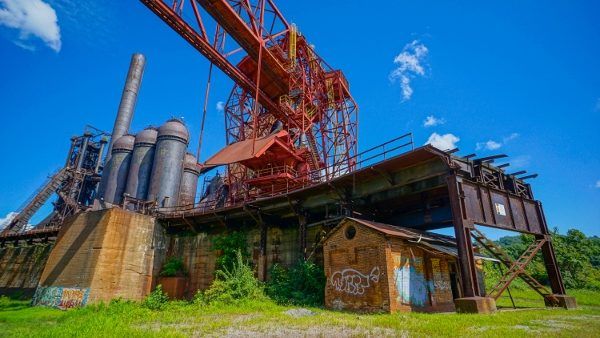
The decline of the steel industry in Pittsburgh is unique in that it was so recent. Often we look back at fallen industries or historical events and can only turn to books, museums, and documentaries to learn from as the generations who lived through it are no longer with us.
This is not the case for Pittsburgh's steel industry.

Not only does a good percentage of the city remember the steel industry vividly, many worked in it for most of their lives (and have strong feelings on its demise on all sides of the spectrum). This gives the Rivers of Steel Heritage Foundation a unique opportunity when preserving the grounds of the Carrie Furnaces as many of the volunteers actually worked at the furnace itself.
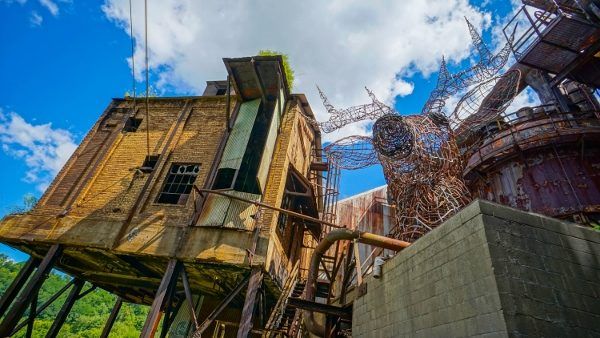
In fact, this was one of the highlights of the tour for us as our guide shared stories of what life was like working at the furnace in addition to its history- including his daily tasks, why the industry was such a livelihood to the city, and even why the industry ultimately collapsed (hint: they refused to modernize).
For those who love Pittsburgh history and have already learned a bit about the steel industry at the Heinz History Center , Carnegie's business partner Henry Clay Frick at the Frick house , and are looking for more, this 2-hour tour does a great job at filling in the gaps while exploring the hauntingly beautiful grounds of what remains of the once massive Carrie Furnaces.

But in keeping with our habit of not giving everything away when it comes to museums and guided tours, we're going to leave the rest for you to find out for yourself on a visit.
• Traveling to Pittsburgh soon? Find a flight deal . • In need of a room? Check out hotel and apartment prices. • Don't overlook picking up a rental car or day tours as well!
One of the Best Tours in Pittsburgh
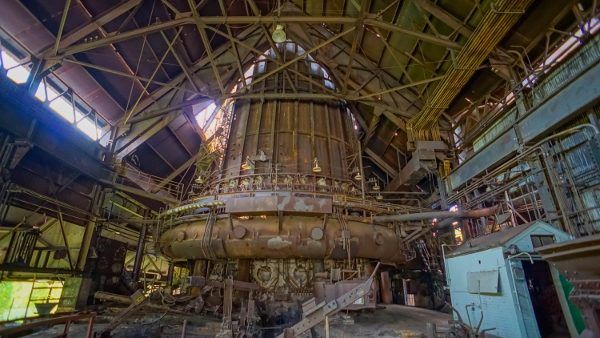
Overall, the tour of the Carrie Furnaces is, without a doubt, one of the best tours you can do in the entire city.
The guides do a stellar job of bringing the history of the furnaces alive, and the tour can only be described as being 100% Pittsburgh. So if you want to find out more about why we are known as the Steel City, do yourself a favor and book a tour as soon as possible.
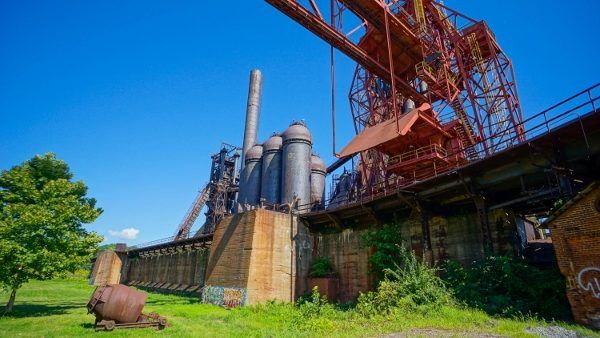
The Carrie Furnaces are located southeast of Pittsburgh just outside of Rankin, PA. Tours are available during the summer months on Saturdays and Sundays and require advanced reservations. For those who want more, be sure to head over to Homestead after your tour to explore more historic sites associated with the steel industry, such as the location of the 1892 Homestead Strike.
To learn more about Pittsburgh's steel heritage , why not tour the Frick House or visit the Heinz History Center ?
Find Another Pittsburgh Attraction

Cornhole Golf at Mars-Bethel Golf Course is a Unique Game
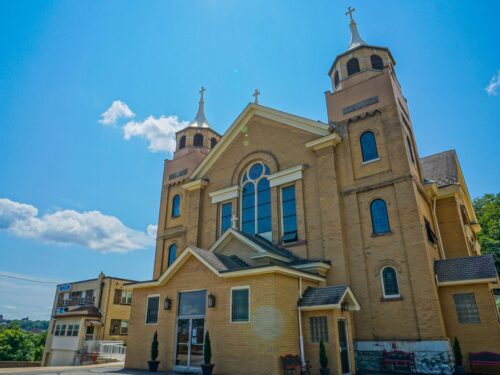
Maxo Vanka Murals at St. Nicholas in Millvale are a Must See

Bracket Night Brings Tournament Style Improv Downtown
Find more to do east of pittsburgh.

Udipi Cafe Review – Southern Indian Cuisine at Its Finest
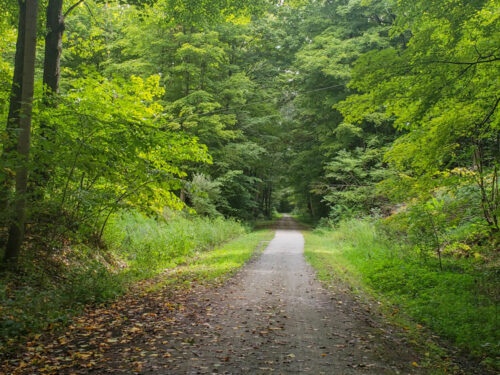
Exploring the Westmoreland Heritage Trail on Foot or Bike

Shelly Pie Review – Large Pizzas in Turtle Creek
1 thought on “carrie furnace tour – finding the steel city’s roots”.
Very helpful, thank you.
Leave a Comment Cancel reply
Save my name, email, and website in this browser for the next time I comment.

Historic Carrie Furnaces Tour: A Pittsburgh Time Capsule
Disclaimer: This post might contain affiliate links, which means we get a small commission if you make a purchase (at no extra cost to you).
Pittsburgh is known for its industrial heritage. In the late 19th and early 20th centuries, Pittsburgh was a top producer of steel, iron, and coke and put millions of American-born and immigrant laborers to work. However, much of that history lives on today in museums, while expansive industrial sites have been redeveloped or abandoned. Carrie Furnaces is an exception.
Preserved by the Rivers of Steel National Heritage Area , Carrie Blast Furnaces National Historic Landmark is a 130-acre former industrial site along the Monongahela River in Pittsburgh. It is one of the last remaining sites of its kind in Pittsburgh, and the only one open for guided tours and events. Here at the Carrie Furnaces, you can walk through history as you explore and tour this historic site near Pittsburgh. As a National Historic Landmark , Carrie Furnaces is nationally recognized as one of the last remaining pre-World War II blast furnaces.
Join us in exploring this time capsule of Pittsburgh’s history as the Steel City! The Carrie Furnaces is one of the most unique things to do in Pittsburgh ! In this post, we’re going to share with your our experience touring the Carrie Blast Furnaces in Pittsburgh!
Touring the Carrie Blast Furnaces, Rivers of Steel
A photo safari tour at carrie furnaces, rivers of steel, history of the carrie furnaces.
Carrie Furnaces is a complex of buildings and structures dedicated to processing iron, a parent material of steel. In the late 19th and early 20th centuries, steel was the preferred material for infastructure and machinery because it was lighter, stronger, and less expensive than iron. Still, iron was the base metal for steel and therefore a necessary ingredient. Iron smelting facilities like Carrie Furnaces were needed to extract the pure iron from the raw ore and send it to steel mills for processing.

Built in 1881, the Carrie Furnaces was part of the Homestead Steel Works, a large network of mills and railways that served as the flagship operation for Carnegie Steel Company and later the U.S. Steel Company. The Homestead Steel Works once sprawled across the shore of the Monongahela River, employing thousands of workers, some of whom participated in the famous Homestead Strike of 1892. The steelworks closed in 1986 as part of the collapse of the domestic steel industry.

Read more about unique things to do in Pittsburgh!
Today, Carrie Furnace is one of the few sites that remains of the Homestead complex, as much of it was razed to build the Waterfront shopping plaza and Sandcastle Waterpark. A line of towering chimneys at the Waterfront and the Hot Metal Bridge are among the remnants.

On top of that, what we see at Carrie Furnaces today is only part of once stood. Only furnaces #6 and #7 remain. These furnaces were built in 1907 and ceased operations in 1978. Carrie Furnaces may look run down and abandoned, but it is actually carefully preserved.

Touring the Carrie Furnaces in Pittsburgh
Carrie Furnaces offers a few types of tours and programs. Rivers of Steel, the organization that oversees Carrie Furnaces, is pioneering unique ways to connect with Pittsburgh’s industrial history through guided tours, art programs, concerts, and festivals.
Carrie Furnaces offers a few special tours:
Industrial Tour
The Industrial Tour connects you with the history of Carrie Furnaces through stories of industry, innovation, and the life of workers and their cultures. Learn how the complex operated from a mechanical standpoint while also discovering how the iron produced at Carrie Furnaces contributed to steel production, the economy, and modern technology.
This tour also explores the lives of thousands of workers, including their work in hot, loud, and dangerous conditions, contributions to workers rights and the labor movement, and their daily lives and diverse cultures.


Arts & Grounds Tour
The urban, rugged look of Carrie Furnaces and its rich history has inspired many artists. Sculptors, painters, photographers, landscape designers, and graffiti artists have used the site to create works of art, many of which are incorporated into the site itself. Carrie Furnaces is not only an outdoor history museum but an artist’s playground. The Arts and Grounds Tour shows you works of art around the site that are not on the Industrial Tour.

Iron Garden Tour
It may be hard to imagine nature flourishing where a blast furnace melted metal and coughed smoke. Yet at the Iron Garden, you can see both nature and artists reclaiming the industrial landscape. In the shadow of Carrie Furnace, the Iron Garden’s trails meander through meadows and groves of young trees. Informative signs explain what you see and the many challenges of caring for a post-industrial landscape.

Other Rivers of Steel Tours and Locations
If you want to continue learning about Pittsburgh’s industrial, you can venture off-site and enjoy other tours offered by Rivers of Steel.
Hop on a riverboat and take the 90-minute Intro to Innovation Tour , where you learn about the ever-changing shores of Pittsburgh’s rivers and enjoy views of the bridges and skylines. Watch demonstrations at a 1900 machine shop in Rice’s Landing, about an hour south of Pittsburgh. Gather some friends and book a special tour of the 1892 Pump House , a key location in the Battle of Homestead , where striking workers faced Pinkerton agents sent to suppress them.
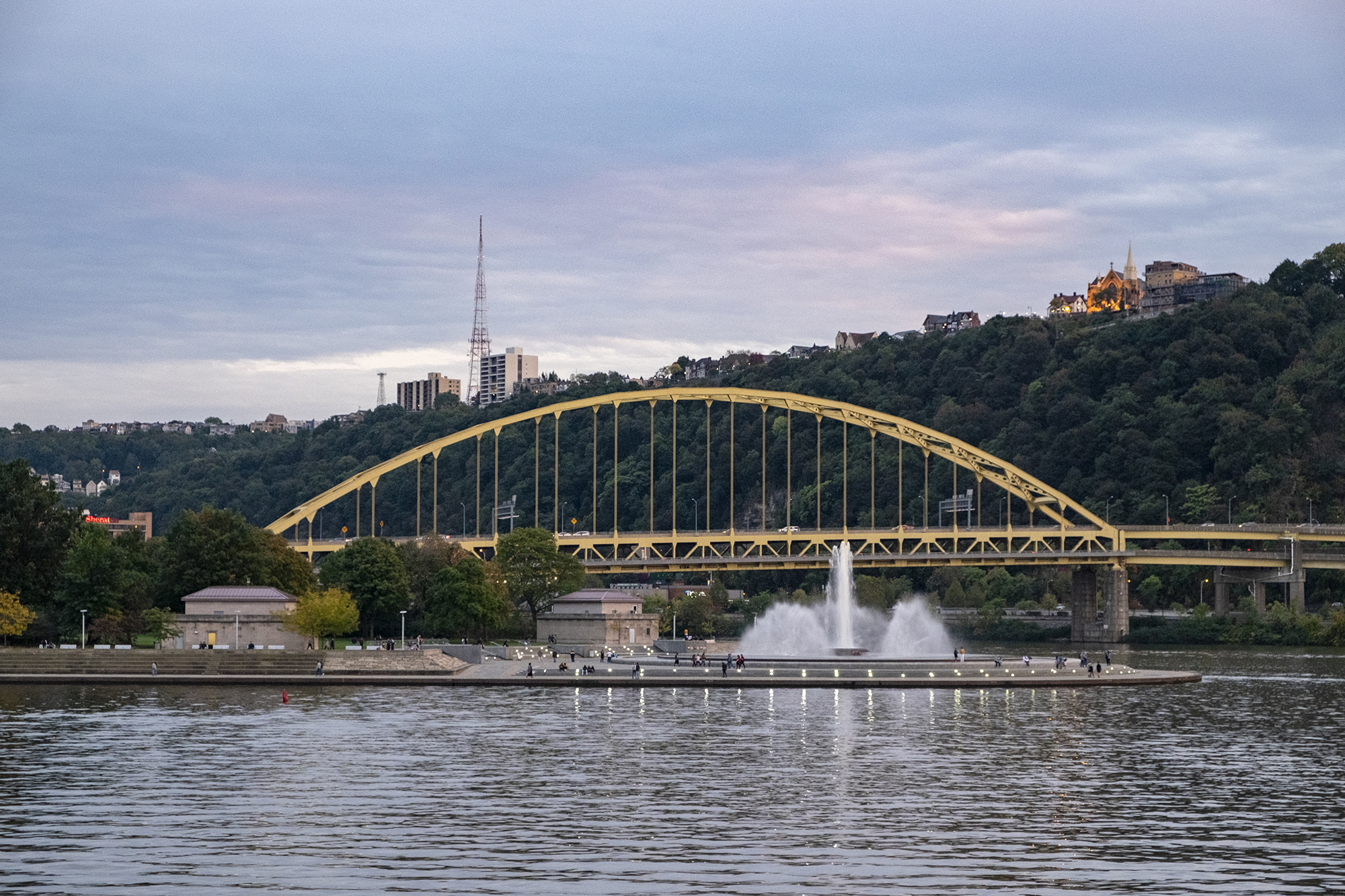
Learn more about things to do in Pittsburgh!
Carrie Furnaces Photo Safari Review
We recently attended a Photo Safari at Carrie Furnaces. This art workshop invites photographers to explore Carrie Furnaces from an artistic perspective. We joined a group of about 20 photographers of all experience levels on a cloudy day in October for our Photo Safari.

The Photo Safari allows photographers free time and essentially free rein to take photographs throughout the complex. Of course, not all sites are accessible for safety reasons, but the site is so large that these restrictions are not noticeable. It is important to note that this walk does not include historical background – book an Industrial Tour to get this experience (and we highly recommend both!)
We booked our Photo Safari online through the Rivers of Steel website. When we arrived, we were greeted by a volunteer, who also happened to be a former steelworker. He gave us a brief orientation before walking us through the site and explaining where we could and could not walk. These rules are important to follow as they keep you and the historic site safe.
Afterward, we had 2.5 hours to take photos. We brought digital and film cameras to play with. A tripod or flash is recommended for interior shots since some areas can be quite dark.
Learn More About Visiting Pittsburgh
- Unique Things to Do in Pittsburgh
- Top Things to do in Pittsburgh
- Winter and Holiday Activities in Pittsburgh
- First Time Visitors Guide to Pittsburgh
- Museums in Pittsburgh

What would you like to experience at Carrie Furnaces?

Subscribe to our youTube!

Take a tour of historic Homestead Steel Works' Carrie Furnaces near Pittsburgh (photos)
- Updated: Apr. 23, 2015, 3:26 p.m.
- | Published: Apr. 23, 2015, 2:26 p.m.
- Susan Glaser, cleveland.com
SWISSVALE, Pennsylvania - Seven miles east of Pittsburgh, rising nearly 100 feet above the Monongahela River, sits a blast from the past - two, in fact.
Two century-old Carrie Blast Furnaces, part of the long-defunct Homestead Steel Works, are open for tours, the center of the Rivers of Steel National Heritage Area , an eight-county region in Western Pennsylvania that seeks to tell the story of steelmaking in America.
Built in 1907, the two Carrie furnaces are among the last pre-World War II blast furnaces still standing in the United States, according to Ron Baraff, director of museum collections and archives at Rivers of Steel, which is part of the National Park Service. Adding to their historic significance: They remain largely as they did a century ago, as they were never modernized or upgraded.
At their peak production, in the 1950s and 1960s, the furnaces produced as many as 1,250 tons of iron a day - which was transported across the river where it was made into steel.
Back in the late 1980s, when the rest of the massive U.S. Steel complex in and around Homestead was sold and razed - later to be developed as a shopping center - a group of volunteers succeeded in saving the two Carrie furnaces from the wrecking ball.
Today, the furnaces are at the center of a growing movement to attract visitors and tourists to the area, an effort not just to boost the depressed region's economic fortunes but also to ensure that an important era of American history isn't forgotten, said Baraff.
"This is unique not just to Western Pennsylvania, but to all of the Rust Belt cities," said Baraff. "This is the story of 20 th century America."
RECOMMENDED • cleveland .com
Steelers vs. Chargers game today: Watch NFL Week 3 live stream free Sep. 20, 2024, 9:08 a.m.
YETI Lowcountry Peach color: Where to buy new limited edition shade Sep. 18, 2024, 11:03 a.m.
Two-hour tours of the furnaces - frequently led by former steelworkers -- resume in May, and run Saturdays through October; Friday tours are added in June, July and August. This summer, Rivers of Steel is celebrating the 100 th anniversary of the hard hat, with discounted tour tickets for $19.15.
Other related nearby sights open to the public include the Pump House, which was the site of the battle between workers and Pinkerton Detective agents during the devastating Homestead Strike of 1892; and the Bost Building, a hotel that served as the temporary headquarters for the Amalgamated Association of Iron and Steel Workers during the strike.
For more information or to schedule a tour: riversofsteel.com .
If you purchase a product or register for an account through a link on our site, we may receive compensation. By using this site, you consent to our User Agreement and agree that your clicks, interactions, and personal information may be collected, recorded, and/or stored by us and social media and other third-party partners in accordance with our Privacy Policy.
Rivers of Steel
- Where To Go
- Interactive Map
- Printable Map (PDF)
- Trail Towns
- Sites & Amenities
- Points of Interest
- Refreshments
- Campgrounds
- Information
Rivers of Steel offers experiences that showcase southwestern Pennsylvania’s industrial and cultural heritage at their historical and 21st-century attractions in the Monongahela River valley and on the Explorer riverboat. Connect with Pittsburgh’s steel industry heritage on a guided tour of the iconic Carrie Blast Furnaces National Historic Landmark in Rankin and Swissvale, once part of the legendary U.S. Steel Homestead Works. Stop along the Great Allegheny Passage in Munhall and you’ll find yourself at the historic Pump House, site of the 1892 Battle of Homestead, which offers travelers a chance to walk a labyrinth, view public art, learn about the history of the site, or simply picnic by the river. Nearby in Homestead is the Bost Building National Historic Landmark, which serves as the Visitors’ Center for the Rivers of Steel National Heritage Area and offers exhibits on the region’s industrial and cultural heritage. Visitors arriving in Downtown Pittsburgh will want to follow the Three Rivers Heritage Trail to the North Shore for a sightseeing excursion on the world’s first green passenger riverboat, the Explorer, which docks at the headwaters of the Ohio River. All boat tour proceeds benefit environmental science education programs on the vessel. Get tickets and information at www.riversofsteel.com.
Pittsburgh factory tours explore Steel City's history

What's a city to do when its iconic industrial infrastructure has become a white elephant? In the Steel City, tourism officials and preservationists declared the situation a learning opportunity, and are adapting defunct factory sites to tell the story of how Pittsburgh made its name.
The Rivers of Steel National Heritage Area has transformed the defunct Homestead Steel Works site, which at its peak produced a third of the nation's steel, conducting tours that explain how it was produced and the rich history of the industry. Some are led by former steel mill workers, who lead visitors through hands-on displays in the Carrie Blast Furnaces complex.
Visitors also will find other converted industrial facilities, public art crafted from steel, and, as a bonus for cyclists, the newly completed Great Allegheny Passage bike trail, which goes from Pittsburgh to Washington, D.C., passes right by the site.
Tours range from $15-$25 and are conducted from April-October; find more visitor information at riversofsteel.com .
Travelers interested in the Northeast's industrial heritage will find similar reuse of historic sites at the Lowell National Historic Park in Massachusetts, and Buffalo's Silo City , where new art and architecture projects, and even a massive climbing wall, sit among the world's greatest concentration of historic grain elevators.
- Free Things to Do
- Tours & Sightseeing
- Outdoor Adventure
- Arts & Culture
- Health & Wellness
- Pittsburgh Sports Teams
- Casinos & Gaming
- Film Festivals
- Submit Your Event
- This Week in Pittsburgh
- Annual Events
- Holiday Events
- Halloween Events
- Food Festivals
- Marathons, Runs & Walks
- Pittsburgh Celebrates Juneteenth Freedom Day
- Pittsburgh Black Music Festival
- Hotels & Resorts
- Bars & Nightlife
- Pittsburgh Craft Breweries
- Wineries & Distilleries
- Farms & Farmers Markets
- Pittsburgh Insiders Guide
- Multi-lingual Brochures
- Beyond Pittsburgh
- Transportation
- Explore Black Culture & Heritage
- LGBTQIA+ Travel in Pittsburgh
- Pet-friendly Travel
- College Visits
- Senior Travel
- Medical Travel
- Accessibility Guide
- Welcome Centers
- Downtown Pittsburgh
- Strip District
- Mount Washington
- North Shore & North Side
- Lawrenceville
- East Liberty
- Squirrel Hill
- Monroeville
- Meet in Pittsburgh
- Event Services
- Marketing Toolkit
- Show Your Badge
- About SportsPITTSBURGH
- Sports Event Planner
- Sports Facilities
- Calendar of Events
- Sports Event Attendee
- Power of Sports Economy
- Weddings & Reunions
- Discover Your Persona
Rivers of Steel Tours
Rivers of Steel's attractions showcase the artistry and innovation of southwestern Pennsylvania's rich heritage.
Hop on Rivers of Steel's Explorer riverboat for the Uniquely Pittsburgh Sightseeing Tour , a 90-minute sightseeing cruise of Pittsburgh's three rivers that seeks to answer the question “What makes Pittsburgh, Pittsburgh?” This tour shares the big stories of our region’s past—along with many lesser-known tales—as it explores a sense of place. Looking for an experience unique to the Steel City? Visit the Carrie Blast Furnaces National Historic Landmark . A remnant of the once massive, U.S. Steel Homestead Works, the Carrie Furnaces are also a vestige of Pittsburgh's 20th-century dominance of the steel industry. Guided tours lead guests though the belly of this industrial beast, highlighting the drama of the iron-making process, while sharing the stories of the site's technology, its workers, and their culture. The Bost Building National Historic Landmark serves at the Visitor’s Center for the Rivers of Steel National Heritage Area . Exhibits highlight the region’s steel heritage and the 1892 Battle of Homestead, along with temporary art and history exhibitions. Information about more tours, other attractions, and the Rivers of Steel National Heritage Area is available at riversofsteel.com .
Rivers of Steel Tours 623 East Eighth Ave. Homestead, Pennsylvania 15120
Related Stories & Events
NCAA® March Madness® Guide to Pittsburgh
Your companion piece for enjoying the best of Pittsburgh between buzzer beaters
This site uses cookies to enhance your experience.
Experience Builder
Quick search, location map.
Homestead Pump House
Basic information for the homestead pump house.
Address: 880 E Waterfront Dr, Munhall, PA 15120
Hours: Dusk til Dawn
Tours available
Website: www.riversofsteel.com
Admission: Free
Transportation: Car (parking available)
Access: Outdoor trail
About the Homestead Pump House
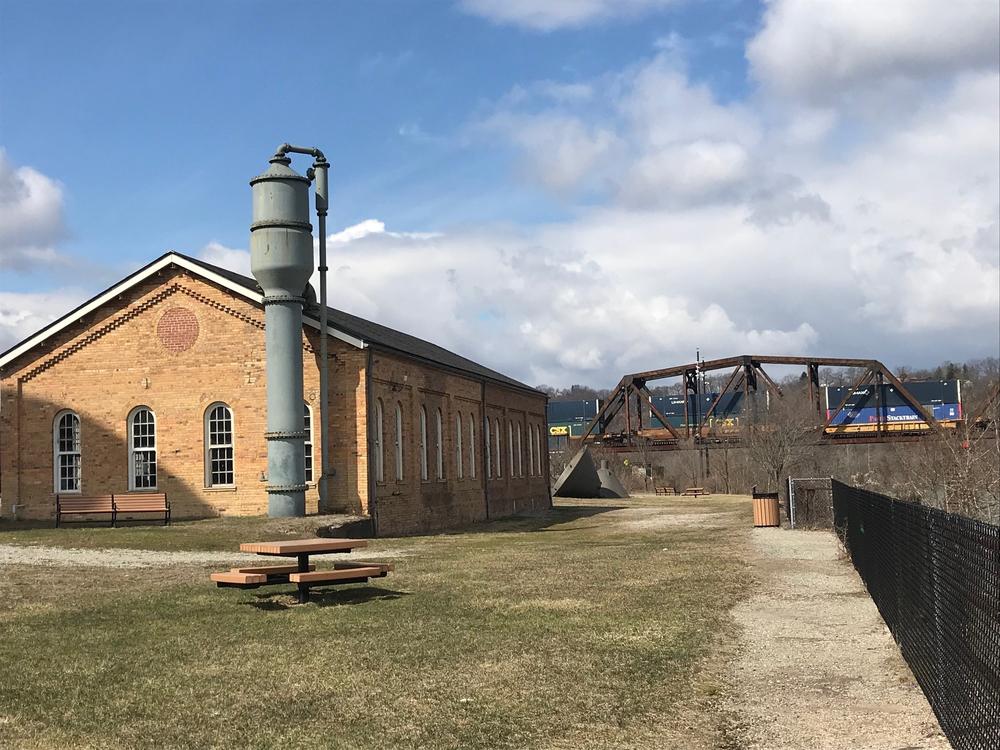
The Pump House was an essential feature of the Homestead Steel Works. In fact, pump houses were essential to all steel mills in the Monongahela Valley. The rivers of Pittsburgh were harnessed through pumping mechanisms to help cool and transport materials for the massive industrial works. The historical significance behind the Pump House is tremendous. In addition to being near the location where generations of Homestead Steel workers would collect their wages, it is the site of one of the deadliest labor confrontations in US history. In 1892, unionized steel workers in Homestead went on strike for better pay and improved working conditions. With increased aggression, mill operator Henry Clay Frick brought in private Pinkerton soldiers to protect the mill. On the morning of July 6, Pinkerton soldiers crossed the river on barges to the site where the Pump House still sits, only to be met with outrage from the community of Homestead. The strike eventually lost momentum, resulting in a loss for the strikers. Today, the Homestead Pump House symbolizes the foundations of Pittsburgh’s steel industry: dependency on rivers, mechanized power, and the steel workers of Pennsylvania. Like the materials manufactured and refined in the Homestead Works, the Monongahela River itself was constantly being tamed by the men who produced Pittsburgh’s gold: Steel.
The Homestead Pump House is of the last remaining structures from the Homestead Steel Works. Today, the site is maintained by a non-profit organization committed to preserving Pittsburgh’s steel history. This organization, Rivers of Steel National Heritage Area, has used the pump house to help educate the community about the history of Homestead now that much of the steel industry is gone. Aside from scattered industrial equipment, now enshrined as art installations in the Waterfront Mall of Homestead, the Pump House and retired smokestacks mark the general expanse of the Homestead Steel works. Thanks to the organization, Rivers of Steel, visitors to Homestead can walk the path of industrial history from one end of the Steel Works site to the other. The path is part of both the Steel Valley Trail and the larger Great Allegheny Passage which extends as far as Washington D.C. After traversing the Rivers of Steel path, visitors may continue along the trail to visit other sites of Pittsburgh’s historic steel industry or enjoy the river scenes on foot or by bicycle. The trail head is located at the Homestead Pump House site.
The Pump House also serves as a modern art center. On site there is an artistic steel sculpture that represents the struggle of steel workers during th e late 19th and early 20th centuries. There is also a public art Labyrinth, created by Lorraine Vullo in 2009. The labyrinth serves as a memorial to those who died during the Battle of Homestead, and is intended to be a meditative space for visitors. The l abyrinth is made up of more than 250 stones, all labeled with names of regional steel mills and blast furnaces. The Pump house is a portion of the Homestead Works Tour Loop hosted by Tour Anytime. This tour includes an in-depth history of the Homestead works area and the Carnegie Steel Mill that once was the gem of the steel city. You can hear a guided tour on your phone 24/7 by calling the number: 412-254-2154. Visit the Tour Anytime website for the map of the the guided phone tour sites. The Pump House building is also now a space that can be rented out for weddings, beer and wine tastings, and any other events you may like. Reach out to the Rivers of Steel Heritage Area to talk prices and schedule events.
End of Union, End of All
- Read more about End of Union, End of All
The Current Pump House
- Read more about The Current Pump House
The Future Plans for the Old Mill
Pittsburgh has long been proud of its moniker of the ‘Steel City’, it has been ingrained in the culture here ever since Carnegie Steel produced its first batch of steel in 1872. We’ve named our sports teams and our buildings after the mark left by the steel era of the cities history, so clearly Pittsburgh is proud of its past. However with the end of the steel era of the city, sites like these are seen by many as sitting on some valuable real estate that could be used to support the increasingly popular destination that is Pittsburgh.
- Read more about The Future Plans for the Old Mill
The Heart of the Furnace
- Read more about The Heart of the Furnace

The Bost Building National Historic Landmark
The Bost Building was at the center of one of American labor history’s most dramatic episodes—the Homestead Lockout and Strike.
Buy Tickets
- Bost Building
Built in 1892 as a hotel for the rapidly growing worker’s ward of Homestead, the Bost Building was at the center of one of American labor history’s most dramatic episodes—the Homestead Lockout and Strike. Now a National Historic Landmark, the Bost Building serves as the Visitors’ Center for the Rivers of Steel National Heritage Area and offers exhibits on the region’s industrial and cultural heritage.
Visitors’ Center for the Rivers of Steel National Heritage Area
Stop by the Bost Building to discover the many ways to explore the region, purchase tickets for tours of the Carrie Blast Furnaces or on the Explorer riverboat, or simply browse the museum galleries and shop. Attraction guides and suggested itineraries are available.
Exhibitions & Archives
Rivers of Steel is home to an extensive archival collection related to Big Steel and its associated industries. Collections include art, artifacts, documents, photographs, and audio-visual materials.
In the galleries, guests can explore permanent exhibits on the U.S. Steel Homestead Works, the 1892 Homestead Lockout and Strike, and a chronicle of the restoration of this National Historic Landmark, as well as temporary exhibits that often draw from the resources in the archives.
Rivers of Steel Headquarters
The Bost Building is also home to the offices for most of Rivers of Steel’s staff. Rivers of Steel works to strengthen the economic and cultural fabric of western Pennsylvania by fostering dynamic initiatives and transformative experiences. Much of this work focuses on managing visitor-centered heritage attractions, but behind the scenes Rivers of Steel works with a diverse network of community partners to support grassroots initiatives and the new regional economy.
Museum Shop
Group tours.
Rivers of Steel offers a variety of ways for groups to experience our attractions—and locations throughout the eight-county National Heritage Area.
See our group tours page for more information on how to incorporate your specific interests and customize your group’s visit.
Meetings & Events
The Bost Building’s third floor gallery is available for social or cocktail-style receptions. It is available year round and provides a welcoming space for groups of 100 or less to gather and mingle amidst the art and artifacts of southwestern Pennsylvania’s industrial past.
Hours & Admission*
The Bost Building is currently open Monday through Friday. Admission times are 11:00 a.m., 12:00 p.m., 1:00 p.m., & 2:00 p.m. $5.00 suggested donation.
Location & Directions
The Bost Building is located at 623 E. Eighth Avenue, Homestead, PA 15120. Free parking for visitors is available in the lot behind the building which is accessed from Heisel Street.
One of five Rivers of Steel attractions
Rivers of Steel The Bost Building 623 E. Eighth Avenue Homestead, PA 15120
Tel: 412.464.4020 Fax: 412.464.4417
Get the Latest
Sign up to hear all about upcoming events and recent news from Rivers of Steel.
Example: Yes, I would like to receive emails from Rivers of Steel. (You can unsubscribe anytime)

© 2024 Rivers of Steel.
- Industrial Tour
- Guided Machine Shop Tours
- The Black Experience at the Carrie Furnaces
- Arts & Grounds Tour of the Carrie Blast Furnaces
- Hands-On Graffiti Tours
- Graffiti Arts
- Photo Safaris
- Professional Development
- Team-Building
- Safety First
- Alloy Pittsburgh
- Gledaj! The Gaze of Maxo Vanka
- In the Wide View
- Mini Greens 2
- Festival of Combustion
- Hammer-In Blacksmithing Festival
- Carrie: After Dark
- Carrie Blast Furnaces
- W.A. Young & Sons Foundry and Machine Shop
- Industrial Grit and Graffiti
- Exhibitions
- Mon Valley Creative Corridor
- Student Programs at the Carrie Blast Furnaces
- Residency and Outreach Programs
- Virtual Education Programs
- Heritage Sites
- Preservation Projects
- Thing to do in the Heritage Area
- Rivers of Steel Heritage Tours
- Outdoor Recreation
- Community Partnerships
- Mini-Grant Funding Opportunity
- About the Heritage Area
- Event Spaces
- Realting.com
- Omsk Oblast
- Residential
Residential properties for sale in Omsk Oblast, Russia
Similar properties in the surrounding area.

Properties features in Omsk Oblast, Russia

IMAGES
VIDEO
COMMENTS
Connect with Pittsburgh's steel industry heritage on this guided tour of the Carrie Blast Furnaces National Historic Landmark. Tours highlight the site's iron-making technology, its workers, and their culture. ... Homestead, PA 15120. Tel: 412.464.4020 Fax: 412.464.4417. [email protected].
A remnant of the legendary U.S. Steel Homestead Steel Works, the Carrie Blast Furnaces are a vestige of Pittsburgh's 20th-century domination of the steel industry. During this two-hour guided tour, you'll hear stories about the site's technology, including why it is nationally significant, as well as get to know the culture of its workers.
Carrie Blast Furnaces. Towering 92 feet over the Monongahela River, constructed of 2.5″ thick steel plate and lined with refractory brick, Carrie Furnaces #6 and #7 are extremely rare examples of pre-World War II iron-making technology. Since the collapse of the region's big steel industry in the 1970s and 1980s, these are the only non ...
Located just outside the Pittsburgh city limits, Carrie Blast Furnace was once part of the Homestead Steel Works. The two furnaces that make up the site were built in 1907 by Carnegie Steel and ran almost continuously until 1978. Carrie Furnace is the only example of a pre-World War 2 iron furnace left in Pittsburgh.
Rivers of Steel. Built in 1892 as a hotel for the rapidly growing worker's ward of Homestead, the Bost Building was at the center of one of American labor history's most dramatic episodes—the Homestead Lockout and Strike. Now a National Historic Landmark, the Bost Building serves as the Visitors' Center for the Rivers of Steel National ...
A remnant of the legendary U.S. Steel Homestead Steel Works, the Carrie Blast Furnaces are a vestige of Pittsburgh's 20th-century domination of the steel industry. During this two-hour guided tour, you'll hear stories about the site's technology (including why it is nationally significant) as well as get to know the culture of its workers ...
The Industrial Tour at the Carrie Blast Furnaces takes place on the grounds of a vestige of Pittsburgh's 20th-century domination of the steel industry. Towering 92 feet over the Monongahela River, the Carrie Blast Furnaces are rare examples of pre-WWII iron-making technology. Since the collapse of the region's steel industry in the 1970s ...
The Rivers of Steel tour of the Carrie Blast Furnaces is a great introduction to the industrial roots of Pittsburgh. ... The brick-lined interior of one of the "torpedo cars" used to transport molten iron across the river to the steel mills in Homestead. This was hot, dangerous, back-breaking work, and these historic furnaces played a ...
The Carrie Furnaces are located southeast of Pittsburgh just outside of Rankin, PA. Tours are available during the summer months on Saturdays and Sundays and require advanced reservations. For those who want more, be sure to head over to Homestead after your tour to explore more historic sites associated with the steel industry, such as the ...
A Photo Safari Tour at Carrie Furnaces, Rivers of Steel ... Iron smelting facilities like Carrie Furnaces were needed to extract the pure iron from the raw ore and send it to steel mills for processing. Built in 1881, the Carrie Furnaces was part of the Homestead Steel Works, a large network of mills and railways that served as the flagship ...
Two century-old Carrie Blast Furnaces, part of the long-defunct Homestead Steel Works, are open for tours, the center of the Rivers of Steel National Heritage Area, an eight-county region in ...
Website: Rivers of Steel's Website Email: [email protected] Phone: 412-464-4020 Follow: Facebook Instagram. Rivers of Steel offers experiences that showcase southwestern Pennsylvania's industrial and cultural heritage at their historical and 21st-century attractions in the Monongahela River valley and on the Explorer riverboat.
The steel works were first constructed in 1881. Andrew Carnegie, (a Scottish emigrant), bought the 2 year old Homestead Steel Works in 1883, and integrated it into his Carnegie Steel Company. [1] For many years, the Homestead Works was the largest steel mill in the world and the most productive of the Mon Valley's many mills.
Connect with Pittsburgh's steel industry heritage on this guided tour of the Carrie Blast Furnaces National Historic Landmark. Tours highlight the site's iron-making technology, its workers, and their culture. ... Site of the 1892 Battle of Homestead and a key part of the U.S. Steel Homestead Steel Works.
Rivers of Steel's attractions include three National Historic Landmarks, including the Carrie Blast Furnaces in Swissvale and Rankin, The Bost Building in Homestead, and the W.A. Young & Sons Foundry and Machine Shop in Rices Landing, in addition to the historic Pump House in Munhall—site of the 1892 Battle of Homestead, and the Explorer ...
The Rivers of Steel National Heritage Area has transformed the defunct Homestead Steel Works site, which at its peak produced a third of the nation's steel, conducting tours that explain how it ...
Rivers of Steel's attractions showcase the artistry and innovation of southwestern Pennsylvania's rich heritage. , a 90-minute sightseeing cruise of Pittsburgh's three rivers that seeks to answer the question "What makes Pittsburgh, Pittsburgh?". This tour shares the big stories of our region's past—along with many lesser-known tales ...
The Pump house is a portion of the Homestead Works Tour Loop hosted by Tour Anytime. This tour includes an in-depth history of the Homestead works area and the Carnegie Steel Mill that once was the gem of the steel city. You can hear a guided tour on your phone 24/7 by calling the number: 412-254-2154. Visit the Tour Anytime website for the map ...
Monument to the Plumber Stepanych. 354. Monuments & Statues. By Annedorte. A plumber coming out of a manhole in the middle of the street. Well done with something fun and surprising. 2. Cathedral of the Assumption of the Blessed Virgin Mary. 246.
Location & Directions. The Bost Building is located at 623 E. Eighth Avenue, Homestead, PA 15120. Free parking for visitors is available in the lot behind the building which is accessed from Heisel Street. Get Directions.
By Andrew M. " A place where dreams come true ". Jul 2018. The Tara gate is one of the four main gates of Omsk fortress. It is also known as the "Northern Gate". The gate was restored in 1991, and is predominately a cream colour with white borders. It was originally built in 1792. We heard that there was a museum at the top of the gate, but ...
10. Omsk State Museum of History and Regional Studies. 52. History Museums. Established in 1878, this museum safeguarded valuable collections during World War II and, after the war, expanded its holdings to reflect the region's rapid social development, economic achievements…. 11. Achairsky Holy Cross Monastery. 86.
Find Residential properties for Sale in Omsk Oblast, Russia Large selection of residential properties in latest listings Actual prices Photos Description and Location on the map.